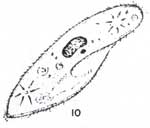One of the protozoans I recently photographed, is Vorticella.
A few evenings ago I captured multiple videos with the same organism.. heavily populated slide with these flower-like contractile stalk organisms.
http://pirx.com/droplet/gallery/vorticella.html contains a clear photograph of this organism I compared with, among others on the web.
"Vorticella is a sessile, peritrich ciliate. Disturbed contracts and myoneme becomes spring-like. The stalk is not branched. Often forms clusters, but not colonies."
I saw two of the stalks interacting to some degree, it's pretty amazing. This was one of my favorites that shows their behavior..
http://www.youtube.com/watch?v=Gn_z5uCokDI They seem to be quite aggressive. These are a parasite in prawns and crawfish, but it seems there's disagreement among culturists / researchers, if its a "most common" or "least common" parasite.
"Hall (1979) found that Corthunia sp, Epistylis sp. and Vorticella sp. were the most common peritrichous ciliates in cultured prawns. Common sites of infestation are the body, eye stalk, antenna, uropods and egg masses. Thelohania, a microsporidian, has been reported in various species of marine shrimps but rarely in freshwater prawns. Areerat (1988) reported one case of microsporidia infection in the opaque muscular tissue of Macrobrachium."
From Diseases of the Freshwater Prawn, Aquatic Animal Health Research Institute
(Our Fundamentals of Aquaculture text, was likely the source I was citing from):
"Ectocommensals are comprised of a variety of protozoan species which live on and/or attach to the surface of the body and the gills of their host. Common parasitic genera associated with crawfish and prawns include Epistylis, Zoothamnium, Lagenophrys, Corthunia and Acineta. Less common genera are Vorticella, Vaginicola and Opercularia."
Anyway.. both agree they're parasitic on prawns and crawfish.
Vorticella spewing waste or another bi-product? black dots / fluid begin spewing from it's bud? (about half-way through video).
http://youtube.com/watch?v=VSzc-Cl8M4Q

Vorticella
Vorticella makes an interesting video subject.
Video #9, Video #8, Video #7, Video #6, Video #5, Video #4, Video #3, and others on youtube.com
A few evenings ago I captured multiple videos with the same organism.. heavily populated slide with these flower-like contractile stalk organisms.
http://pirx.com/droplet/gallery/vorticella.html contains a clear photograph of this organism I compared with, among others on the web.
"Vorticella is a sessile, peritrich ciliate. Disturbed contracts and myoneme becomes spring-like. The stalk is not branched. Often forms clusters, but not colonies."
I saw two of the stalks interacting to some degree, it's pretty amazing. This was one of my favorites that shows their behavior..
http://www.youtube.com/watch?v=Gn_z5uCokDI They seem to be quite aggressive. These are a parasite in prawns and crawfish, but it seems there's disagreement among culturists / researchers, if its a "most common" or "least common" parasite.
"Hall (1979) found that Corthunia sp, Epistylis sp. and Vorticella sp. were the most common peritrichous ciliates in cultured prawns. Common sites of infestation are the body, eye stalk, antenna, uropods and egg masses. Thelohania, a microsporidian, has been reported in various species of marine shrimps but rarely in freshwater prawns. Areerat (1988) reported one case of microsporidia infection in the opaque muscular tissue of Macrobrachium."
From Diseases of the Freshwater Prawn, Aquatic Animal Health Research Institute
(Our Fundamentals of Aquaculture text, was likely the source I was citing from):
"Ectocommensals are comprised of a variety of protozoan species which live on and/or attach to the surface of the body and the gills of their host. Common parasitic genera associated with crawfish and prawns include Epistylis, Zoothamnium, Lagenophrys, Corthunia and Acineta. Less common genera are Vorticella, Vaginicola and Opercularia."
Anyway.. both agree they're parasitic on prawns and crawfish.
Vorticella spewing waste or another bi-product? black dots / fluid begin spewing from it's bud? (about half-way through video).
http://youtube.com/watch?v=VSzc-Cl8M4Q

Vorticella
Vorticella makes an interesting video subject.
Video #9, Video #8, Video #7, Video #6, Video #5, Video #4, Video #3, and others on youtube.com





























